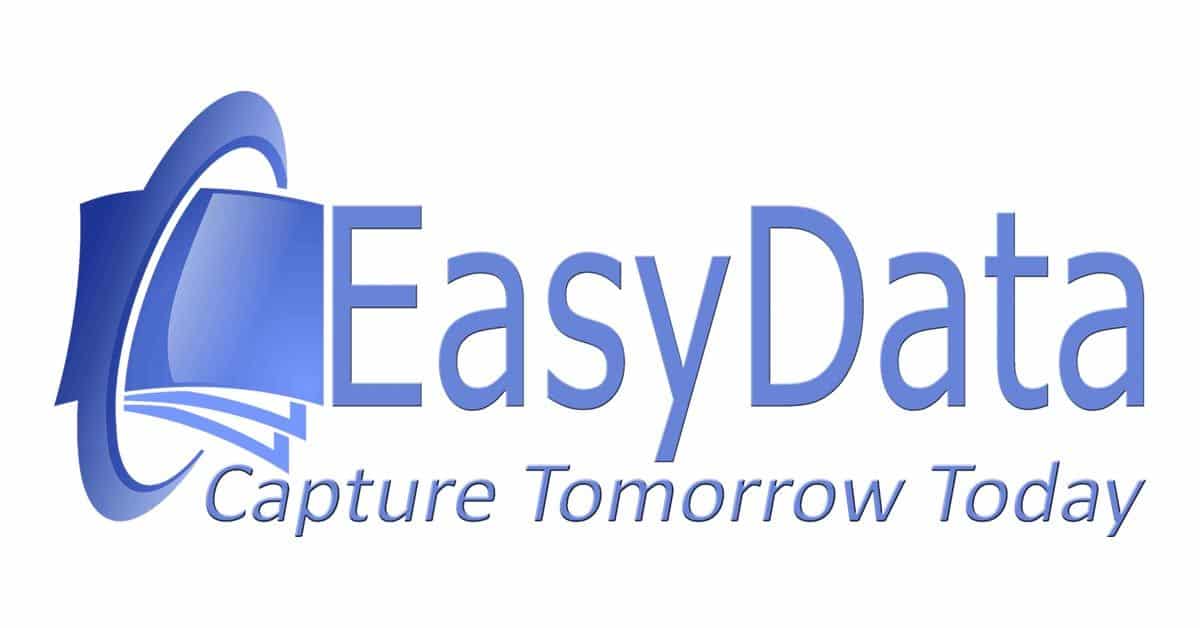Successful Projects in Document Automation
Discover how EasyData empowers organizations with innovative document processing solutions, from bank statement analysis to advanced invoice recognition. We support small municipalities to international enterprises: our proven technologies drive efficiency, cost savings, and improved compliance.
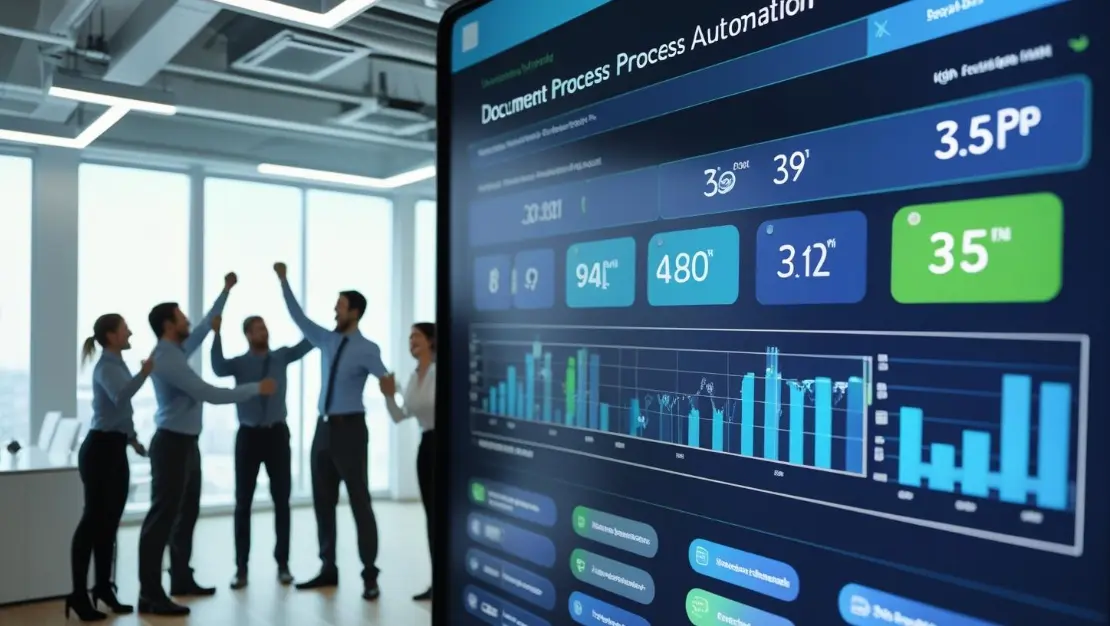
Why Do Organizations Choose EasyData?
For an IT manager at a municipality, it once seemed impossible: automatically processing thousands of bank statements from different banks, without storing sensitive information. That changed with EasyData’s Financial Search solution.
This introduction perfectly illustrates what this article is about: how EasyData helps organizations automate complex document processing with European technology and proprietary data centers. In this article, you will discover concrete examples of successful projects, from invoice recognition to handwriting recognition, and why these solutions are more relevant than ever.
With increasing digitization and stricter privacy requirements, organizations are looking for reliable partners who can guarantee both innovation and compliance. EasyData combines over 25 years of experience with cutting-edge cloud solutions, offering a unique proposition in the market.
Bank Statement Analysis for Dutch Municipality

Dutch municipalities face the challenge of quickly and securely processing bank statements from various banks (ABN Amro, ING, Rabobank, and SNS). We have successfully solved the core of this challenge with our Financial Search technology, which automatically recognizes documents, extracts relevant data, and categorizes transactions using a dynamic system.
The unique aspect of this approach is that categories contain no personal data and—if desired—can be shared with other participating municipalities, creating a network of best practices that are widely applicable.
Main customer benefits:
- Full privacy: No storage of personal data; processing takes place in a strictly secured environment
- Flexibility: Categories can easily be adapted to changing regulations
- Security: Files are delivered via secure channels and deleted immediately after processing
- Scalability: Suitable for large document volumes with transparent tiered pricing
- Expandability: Other document types can be added alongside bank statements
The implementation also included a service desk portal, user logging, and extensive support. Thanks to this integrated approach, participating municipalities can organize their financial processes more efficiently and securely, maintaining full privacy and compliance.
Learn more about our cloud servicesAutomated Invoice Processing for Mid-Sized Company

A successful project involved automating the invoice processing workflow for a mid-sized Dutch company. The goal was to minimize manual processing of incoming PDF invoices and increase administrative efficiency.
Incoming PDF invoices are automatically recognized at line level. Invoices that contain an XML file are immediately forwarded to the desired server location. Recognized invoices are placed via a secure connection in a folder directly accessible to the client’s ERP system.
Special features:
Online verification: Invoices that are not fully recognized automatically are routed to an online verification module. If manual correction is needed, the responsible staff member receives an automatic email notification.
Continuous improvement: Clients can easily submit incompletely recognized invoices for process optimization, making the system smarter over time.
Tangible results:
- Time savings: Processing is largely automatic, allowing staff to focus on more important tasks
- Reliability: Fewer errors due to automatic recognition and verification
- Cost savings: Competitive rate per invoice and reduced manual handling
- Customization: Batch or non-standard invoices can be processed according to specific requirements
OCR Enhancement for Healthcare Sector
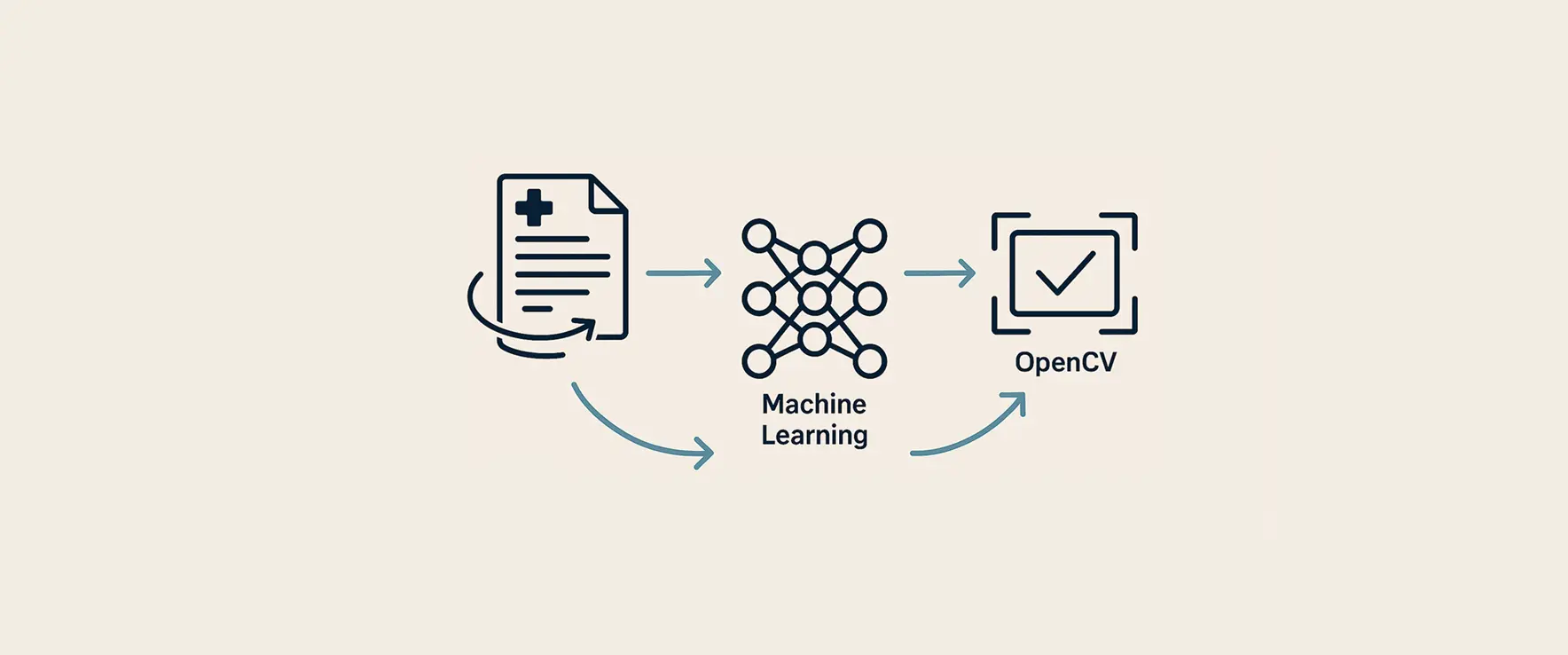
For a leading organization in the healthcare sector, we executed an innovative project focused on improving the recognition of hard-to-read documents. A significant portion of submitted documents could not be automatically recognized by existing OCR systems.
We developed an advanced image enhancement module based on machine learning and OpenCV. This module corrects perspective, restores distortions, and increases the resolution of documents, preparing them optimally for automatic recognition.
Technical innovations:
Hybrid OCR workflow: After image enhancement, only relevant document sections are recognized via a secure workflow using Azure Advanced OCR. This ensures privacy and speeds up the process.
Document splitting and merging: Our technology logically splits documents into recognizable sections, after which results are merged into a single clear text file with PDF reference.
Customer results:
- Higher recognition rate: Significantly more documents are recognized automatically
- Efficient workflow: Document processing turnaround time is greatly shortened
- Scalability: Suitable for large numbers of documents and expandable with new technologies
- Cost savings: Direct savings on time and operational costs due to less manual processing
Complex Invoice Recognition for International Organization
For an internationally operating organization, we carried out a project focused on automating complex invoice processing. The client faced challenges such as high dependence on manual processing, susceptibility to errors, and limited flexibility.

We implemented an advanced solution that automatically recognizes invoices and extracts relevant data—such as suppliers, amounts, VAT rates, and currencies—directly from documents. This was achieved through a combination of template recognition and machine learning.
Special features:
Scalable integration: Fully integrated with the existing ERP system for seamless workflow and prevention of duplicate entries.
Flexible customization: Specific requirements for VAT handling and multi-currency support realized through custom rules. Organizations can easily adapt to changing laws and regulations.
Concrete improvements:
- 70% shorter invoice processing time
- Drastic error reduction compared to manual entry
- Rapid onboarding of new suppliers and invoice formats
- International scalability with support for multiple currencies and VAT regimes
Automated Mail Processing for Government Organization

For a government organization, we executed a project entirely focused on modernizing the processing of incoming mail and documents. The challenge was to efficiently process both paper and digital mail streams, ensure privacy, and realize integration with existing case management systems.
We implemented a solution that allows both physical and digital documents to be centrally scanned, recognized, and automatically provided with relevant metadata. A distinction is made between technical and content metadata, tailored to organizational requirements.
Innovative features:
Case management system integration: Scanned documents, after recognition and classification, are offered to the case management system via a secure link. This allows documents to be used directly as the starting point for new cases.
AI and OCR technology: Through advanced OCR and AI models, documents are accurately recognized and classified. Handwriting recognition (ICR) and QR code recognition are also integrated.
Organizational results:
- Efficient mail processing: Turnaround time is greatly reduced and errors minimized
- Flexibility: Modular design and easily expandable with new document types
- Cost savings: Reduced manual work and optimal use of existing infrastructure
- Privacy and control: Full control over data and processes with maximum privacy assurance
ID Document Recognition for Telecom Sector
For a major player in the telecom and technology sector, we executed a project focused on optimizing the scanning and recognition process for various documents, such as identity cards, bank cards, receipts, and business registry extracts.

Using our EasyData OCR Technology, documents such as passports, ID cards, driver’s licenses, and bank cards are automatically recognized and relevant data extracted. For European identity documents, the MRZ (Machine Readable Zone) is used as the basis for reliable and fast data extraction.
Privacy by design:
To comply with GDPR, anonymized training data is used. If full anonymization is not possible, datasets are composed where one of the main fields is anonymized each time, ensuring end-user privacy.
Concrete advantages:
- Higher reliability: Fewer errors when adding and processing documents
- Efficiency and time savings: Manual checks largely unnecessary
- Privacy and compliance: Full compliance with privacy regulations through anonymized data
- Smooth implementation: Modular setup and central management for quick deployment
Automated Drawing Recognition for Manufacturing Industry

For a leading company in the manufacturing industry, we realized an advanced project aimed at automating technical document processing and performing complex calculations based on drawings. The challenge was to automatically extract data from weld drawings, validate it, and directly translate it into accurate calculations for production and quality control.
Hotfolder automation:
Automatic document processing: Digital drawings are automatically read as soon as they are placed in the correct folder. The system processes PDF files with vector images and text layers, eliminating the need for manual uploads or sorting.
Using machine learning, specific weld symbols and relevant parameters (such as material type, plate thickness, weld length, and angle) are automatically recognized and extracted from the drawings. Missing or unclear fields are flagged, allowing the user to easily supplement or correct them via a user-friendly web portal.
Customer results:
- Efficiency: Processing time for technical documents drastically reduced
- Accuracy: Automatic recognition and validation minimize human errors
- Ease of use: Simple control and data supplementation via web portal
- Full privacy: Local processing without internet connection for optimal security
Material Certificate Recognition for International Industry
For an international industrial organization, we executed a project focused on automatically reading and structuring complex certificate documents, such as material certificates for steel and other metals. The challenge was that these documents were semi-structured: tables and data appeared in various forms and layouts.

Layout-specific extraction:
Customization per document type: Based on the received documents, six unique layouts were identified. For each layout, a dedicated extraction module was developed, tailored to the specific structure and presentation of the data. This ensures high accuracy, even with unusual or less structured tables.
To improve extraction quality, reference lists were used for material types, "Heat No." formats, and diameter ranges. This minimizes errors in reading and validating values and allows deviations to be detected immediately.
Concrete results:
- Efficiency: Manual entry and checking largely replaced by automatic extraction
- Reliability: Validation against reference lists improves data quality
- Ease of use: Uploading and processing via secure NextCloud environment
- Future-proof: New document types can easily be added
Historical Archive Digitization

For an archive institution dealing with large quantities of historical documents—including cards with handwritten notes, files, and inventory lists—we executed a project focused on automating the recognition and digitization of both handwritten and typed texts. The challenge was the enormous variety of handwriting, pencil notes, and varying scan and paper quality.
Multi-engine approach:
Combined technologies: We deployed various OCR and HTR systems, including EasyData OCR, Yandex Vision, and Transcribus, to automatically recognize handwritten and mixed texts. By smartly combining these systems, the chances of successful extraction increased significantly.
For documents with faint pencil notes or low scan resolution, image enhancement modules were applied. The recognized text was used directly to index documents and add metadata, making them searchable in the archive system.
Impactful results:
- Drastic time savings: Processing time per document reduced by a factor of 3 to 5
- Better accessibility: Archive materials fully searchable for researchers
- Higher data quality: Validation with word lists improves accuracy
- Privacy and compliance: Processing in a secure environment according to archive standards
End-to-End Automation for Financial Services
For an international financial services provider, we executed a project focused on fully automating the processing of various documents, such as contracts, invoices, and client forms. The organization dealt with large volumes of documents arriving daily through different channels (email, uploads, cloud folders).
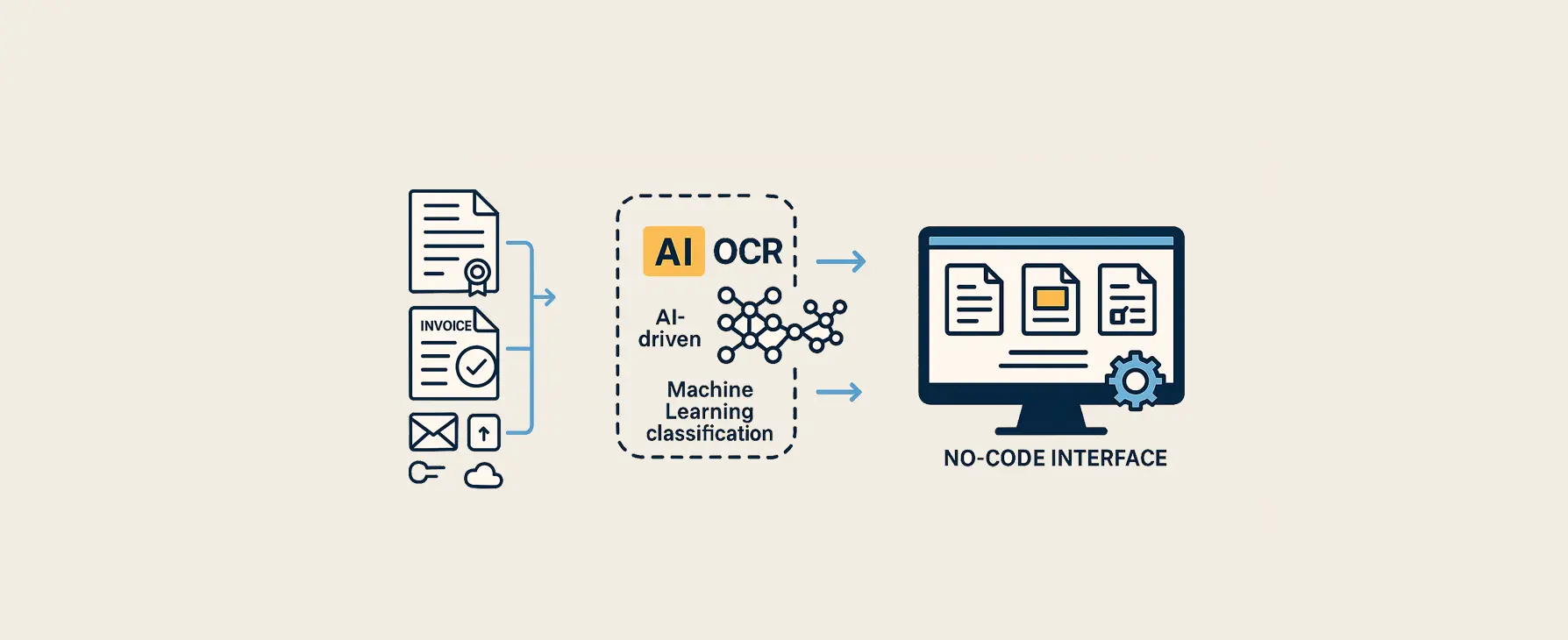
No-code flexibility:
User-friendly configuration: The automation is set up for different document types, including invoices, contracts, shipping labels, and client forms. Thanks to a no-code interface, employees can easily create and modify templates without programming knowledge.
We set up a workflow where documents are automatically retrieved from various sources, recognized, categorized, and relevant data extracted using AI-driven OCR and machine learning technology. The extracted data is automatically validated and sent directly to backend systems.
Measurable improvements:
- Time savings: Processing time reduced from hours to seconds
- Fewer errors: Error rate in data entry drastically reduced
- Scalability: Effortlessly handle large volumes, even during peaks
- Cost savings: Lower operational costs due to less manual work
Fraud Detection for Government Organization
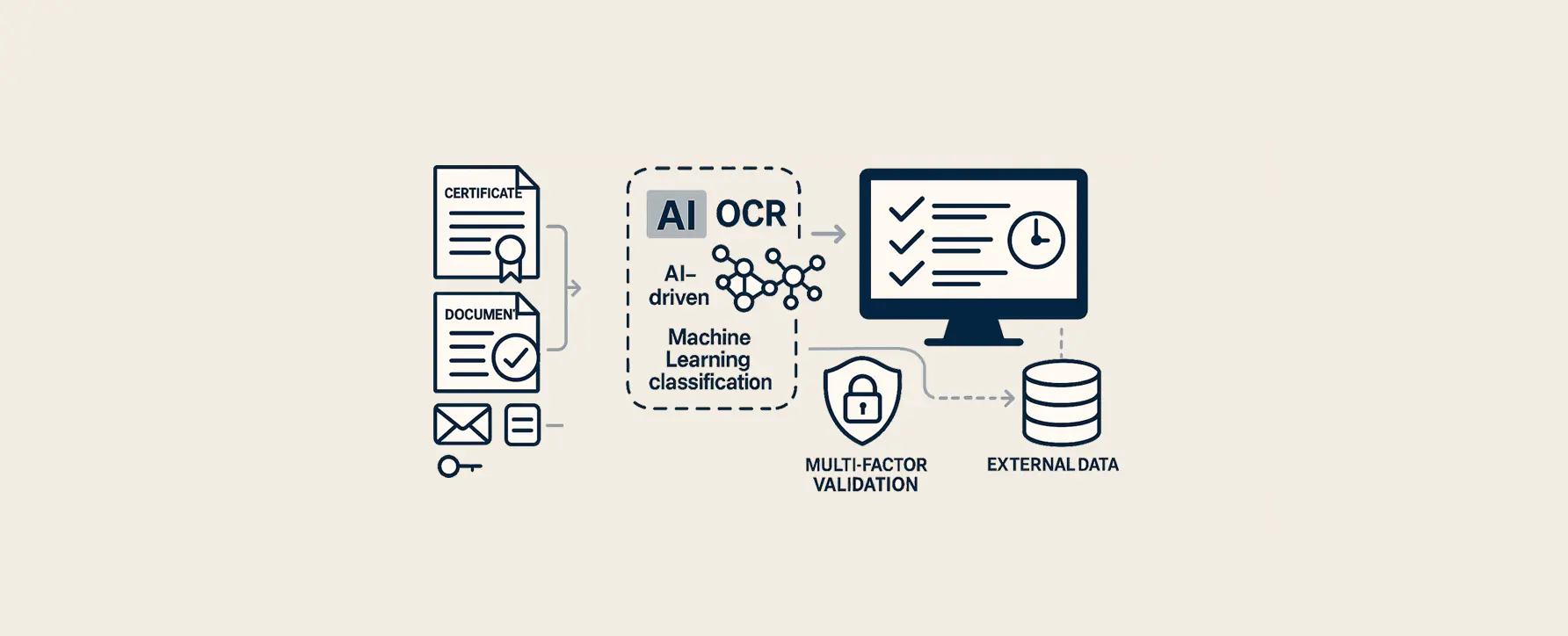
For a government organization, we set up an innovative project focused on automating the processing and validation of certificates and trade documents. The challenge was to quickly and reliably distinguish between genuine and fraudulent documents, recognizing and analyzing both handwriting and machine-written text.
External data integration:
Multi-source validation: Where necessary, additional data is automatically retrieved from reliable online sources to strengthen validation and ensure information completeness. This greatly increases the reliability of fraud detection.
Using our proprietary OCR technology and handwriting recognition modules, documents are read accurately, with missing or unclear data automatically flagged. Documents are classified and validated using reference lists and metadata.
Security and efficiency benefits:
- Fast and reliable recognition: Inspection turnaround time significantly reduced
- Improved fraud detection: Deviations and potential fraud detected more quickly
- User-friendliness: Clear interface with option for manual intervention
- Privacy and compliance: Full compliance with privacy regulations with minimal data storage
Automated Order Processing for Trade & Distribution Company

For a trade and distribution company with a high volume of order processing, we executed a project focused on automating and optimizing the order process. The existing solution was no longer adequate: important order details were lost and much manual checking was required, leading to delays and errors.
Machine Learning optimization:
Self-learning system: Orders that meet the validation threshold are directly exported as PDF with accompanying XML data. Orders with uncertainty are routed to an online validation portal (EasyVerify) for manual checking and model training. This makes the system smarter over time and reduces manual corrections.
The system is trained to recognize essential data such as delivery address, customer number, email, IBAN, phone numbers, order numbers (both dealer and end-customer), and tables with quantities and item numbers. Unknown or incomplete data is automatically supplemented via a database lookup.
Business benefits:
- Efficiency: Order processing is largely automatic with greatly reduced turnaround time
- Cost savings: Fewer manual actions and competitive rate per processed order
- Ease of use: Simple checking, training, and reporting for staff
- Future-proof: Flexible, scalable, and expandable with new features
Document Anonymization for Technology Company
For a technology company specializing in data protection, we executed a project around the development and implementation of an advanced solution for document anonymization. The client wanted to respond to the growing demand for privacy protection when processing large volumes of sensitive documents.

Named Entity Recognition:
Intelligent recognition: By deploying advanced machine learning technologies and NER models, personal data, signatures, and sensitive entities are automatically recognized and anonymized. The system continuously learns from feedback and new datasets.
We fully integrated the existing anonymization platform with a scalable cloud environment. As a result, large numbers of documents can be processed quickly and securely, with page-by-page processing running in parallel for maximum speed and capacity.
Strategic results:
- Fast processing: Large volumes of documents are securely anonymized in a short time
- High accuracy: Reliable recognition and masking of sensitive data
- Flexibility: Grows with changing requirements and easily expandable
- Market position: Solid foundation for further growth and innovation through collaboration
Financial Report Conversion for National Organization

For a national organization responsible for providing insight into large volumes of annual accounts and financial reports, we executed a project focused on converting and structuring unstructured financial documents. The challenge was to quickly and accurately extract relevant financial data from thousands of annual reports.
Automatic web crawling:
Intelligent collection: With our Financial Search solution, annual accounts are automatically collected, recognized, and converted into structured data. The system can search the internet for annual reports, download them, and categorize them based on relevant features such as company name, reporting year, and stock exchange listing.
Using smart algorithms, consolidated balance sheets and other key data are automatically recognized, checked for completeness, and compiled into a clear Excel file or database. The export can be fully tailored to the client’s wishes and is suitable for further analysis or monitoring.
Analytical advantages:
- Efficiency: Processing time for annual accounts drastically reduced
- Reliability: Data accuracy greatly increased through automatic validation
- Insight and control: In-depth analyses possible for better decision-making
- Future-proof: Grows with new requirements and developments
Technical Archive Optimization for Theme Park
For a large Dutch theme park, we executed a project focused on optimizing the findability and accessibility of a large technical archive. The challenge was to make thousands of technical drawings, maintenance documents, and inventory lists more searchable for technical staff.

Smart metadata enrichment:
Automatic structuring: By applying smart algorithms, we were able to extract relevant data from scanned documents and enrich it with metadata. This made it possible to categorize documents by, for example, attraction name, document type, year, or supplier.
We started with a thorough inventory of the archive material from multiple attractions. This included reviewing the structure of existing folders, the presence of inventory lists, and the quality of technical drawings and maintenance documents. For documents with poor scan quality, image enhancement was applied.
Operational improvements:
- Fast findability: Staff can easily search and immediately find the right documents
- Better structure: Archive is future-proof and flexible due to metadata addition
- Fewer errors: Central access prevents duplicate or incomplete scans
- Expandability: Ready for further digitization and new document types
Transport Document Processing for Logistics Service Provider

For a logistics service provider active in international trade, we realized a project focused on automating the processing and checking of transport and freight-related documents, such as CMRs, loading and unloading forms, and accompanying certificates. The client wanted to drastically reduce manual checks and minimize compliance risks.
Compliance automation:
Automatic validation: The system automatically checks whether all required documents are present (such as tank cleaning certificates, accompanying letters, and declarations of previous cargo). Missing or deviating documents are immediately flagged, so staff can intervene quickly.
All submitted transport documents are automatically recognized and relevant data—such as PO/SO number, truck and trailer information, loading and unloading locations, and product details—are extracted. The system is flexible enough to process different languages, layouts, and document types, including handwritten and stamped fields.
Logistics optimizations:
- Efficiency: Processing time per transport dossier reduced by more than 80%
- Error reduction: Errors and compliance risks greatly reduced by automatic validation
- Transparency: Documents centrally organized with full logging and audit trail
- Flexibility: Easily adaptable to new document types and compliance requirements
Claim Processing for International Insurer
For an international insurer, we realized a project that transformed the entire process of processing medical claims. The challenge was to quickly, accurately, and securely process large numbers of scanned claim forms from various insurance companies and in different formats.
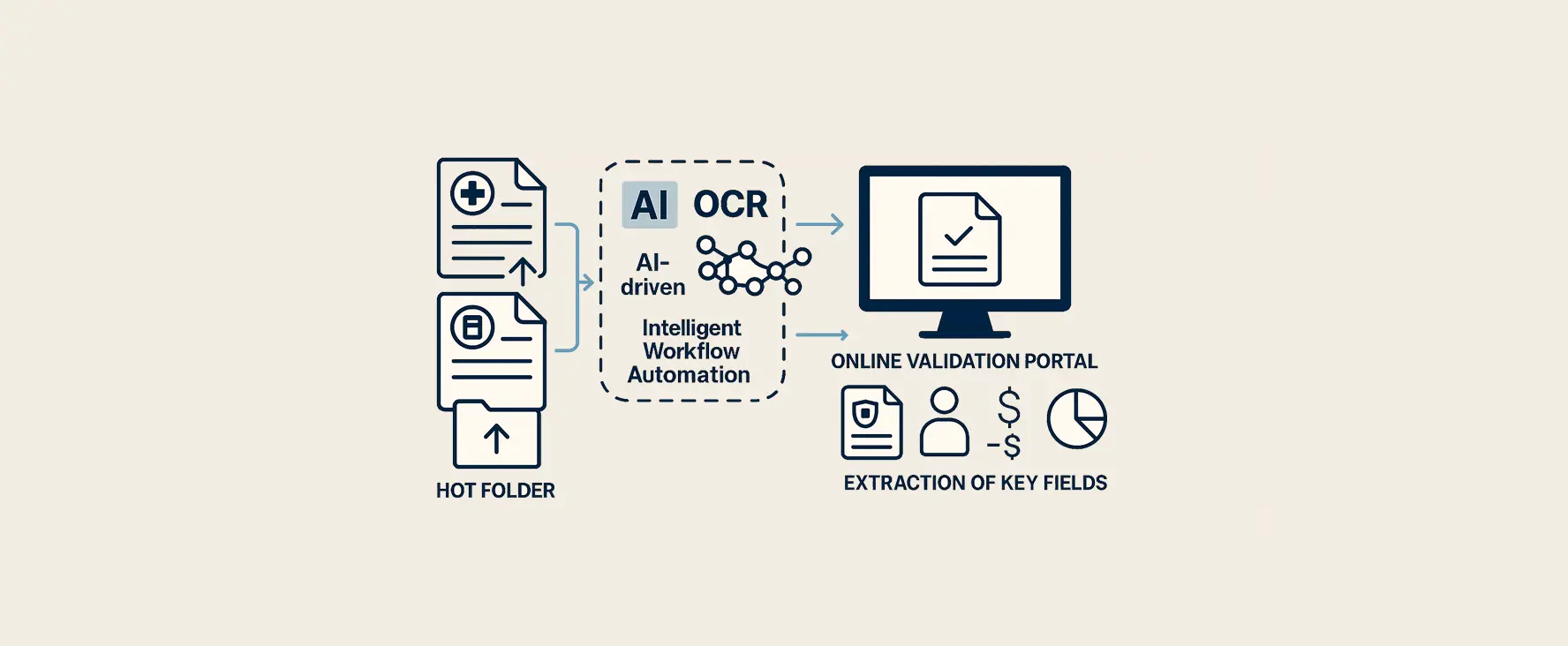
Intelligent workflow automation:
Hot folder processing: Documents are automatically picked up and processed via a 'hot folder.' Only documents with ambiguities or missing data are sent to an online validation portal, where operators can quickly correct errors. This drastically reduces manual workload.
Using an advanced platform, scanned claim documents are automatically recognized. Important fields such as policy data, insured quantities, amounts paid and outstanding claims, and breakdowns by type of care are directly extracted from the documents. The system adapts to different document structures and can quickly add new templates.
Insurance-related benefits:
- Efficiency: Claim processing time reduced by more than 80%
- Accuracy: Number of errors and corrections greatly reduced by automatic validation
- Cost savings: Significant reduction in operational costs due to less manual work
- Future-proof: Grows with new requirements and international expansions
WOZ Objection Processing for Regional Government
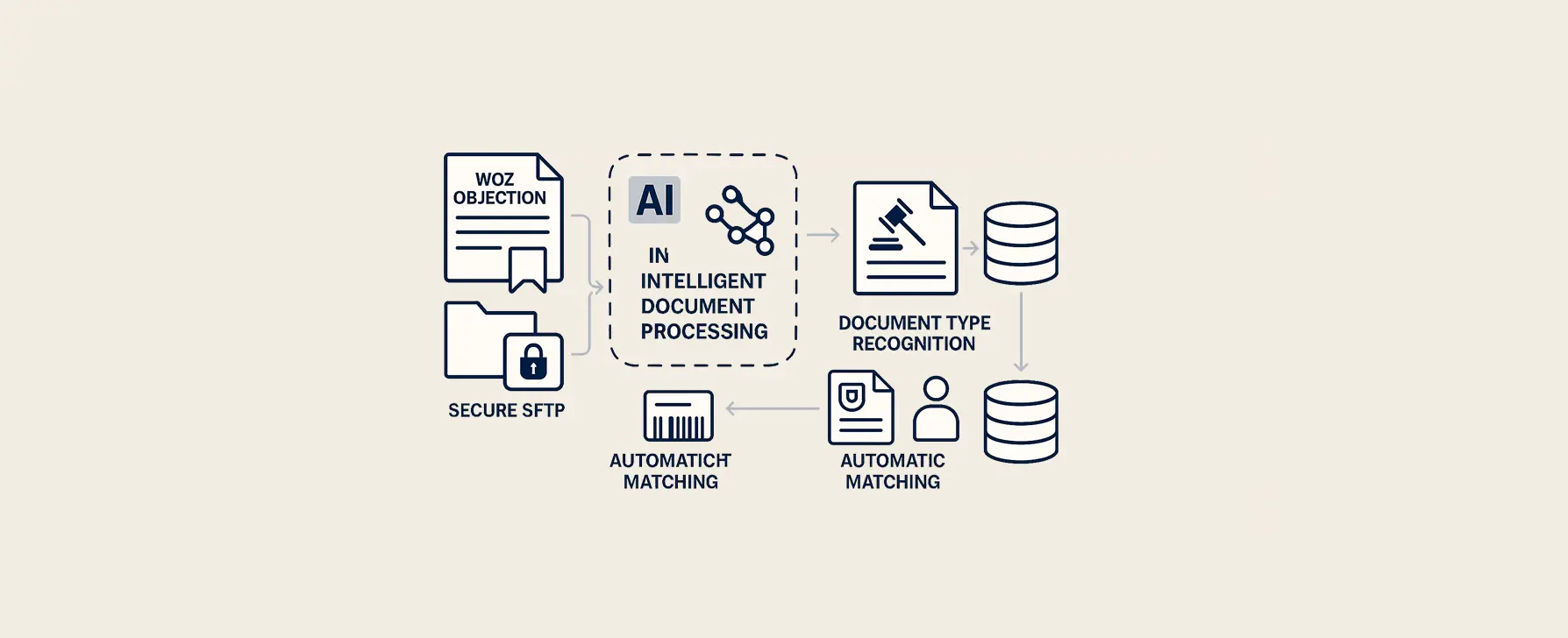
For a regional government organization, we executed a project in which the processing of objection and court documents was fully automated. The challenge was to efficiently and error-free link incoming WOZ objections and court mail to the correct files, integrating various document types, barcodes, and databases.
Intelligent file linking:
Automatic matching: Through intelligent field recognition, relevant data such as file number and customer number are read. Based on the file number, additional information such as the submitter’s name is automatically retrieved and added. Barcodes are actively used to speed up recognition.
Incoming objections are automatically retrieved from a secure SFTP location. The system recognizes the document type, reads assessment and file numbers, and links them directly to the correct records in the database. Court documents are recognized based on unique features and matched with existing files.
Public sector advantages:
- Efficiency: Manual processing virtually unnecessary with greatly reduced turnaround time
- Reliability: Minimal chance of errors due to automatic matching and barcode recognition
- Scalability: Easily expandable with new document types or recognition rules
- Cost control: Operational costs decrease and team capacity is optimally utilized
Why These Projects Were Successful
These cases show that successful document automation is not just about the latest technology, but about understanding specific client needs and delivering solutions that truly work in practice.
Common success factors:
European technology and compliance: All projects were executed with EasyData’s proprietary technology, hosted in Dutch data centers according to European privacy standards.
Customization within standard frameworks: Each solution was tailored to specific requirements but built on proven technical foundations.
Hands-on implementation: Through intensive collaboration and knowledge transfer, clients became self-sufficient in using their systems.
From bank statement analysis to handwriting recognition, from invoice processing to fraud detection—each project demonstrates how thoughtful automation helps organizations work more efficiently, accurately, and securely. The secret lies in combining advanced AI technology with deep understanding of business processes and a pragmatic implementation approach.
Curious how EasyData can transform your document processes? These projects prove that effective automation is within reach, regardless of the complexity of your document flows.
Frequently Asked Questions about Document Automation
How long does it take to implement a document automation solution?
Implementation time varies depending on complexity and scope. Simple invoice recognition can be operational within 2–4 weeks, while more complex solutions such as full mail processing may take 2–3 months. EasyData is known for short implementation periods thanks to proven technical frameworks.
What privacy guarantees does EasyData offer?
All EasyData solutions are hosted in Dutch data centers according to European privacy standards. We work with privacy-by-design principles, anonymized training data where possible, and offer both cloud and on-premise implementations. Clients retain full control over their data.
Can existing systems be integrated?
Yes, EasyData specializes in seamless integration with existing ERP, CRM, and case management systems. By using standard APIs, XML export, and custom integrations, we ensure that new automation fits your current IT infrastructure without major disruptions.
What are the typical cost savings?
Clients report an average 70–80% reduction in processing time, drastic reduction of input errors, and significantly lower operational costs. The exact savings depend on the current process and document volume, but ROI is usually achieved within 12–18 months.
How accurate is automatic document recognition?
Accuracy varies by document type and quality. For structured documents such as invoices, we achieve 95–99% accuracy. For more complex documents such as handwritten texts, this is between 85–90%. All systems have validation workflows for human checks where needed.
Is staff training required?
EasyData provides extensive training and documentation with every implementation. Thanks to user-friendly interfaces and no-code configuration, employees can quickly work independently. We provide both on-site training and online workshops tailored to your organization.
